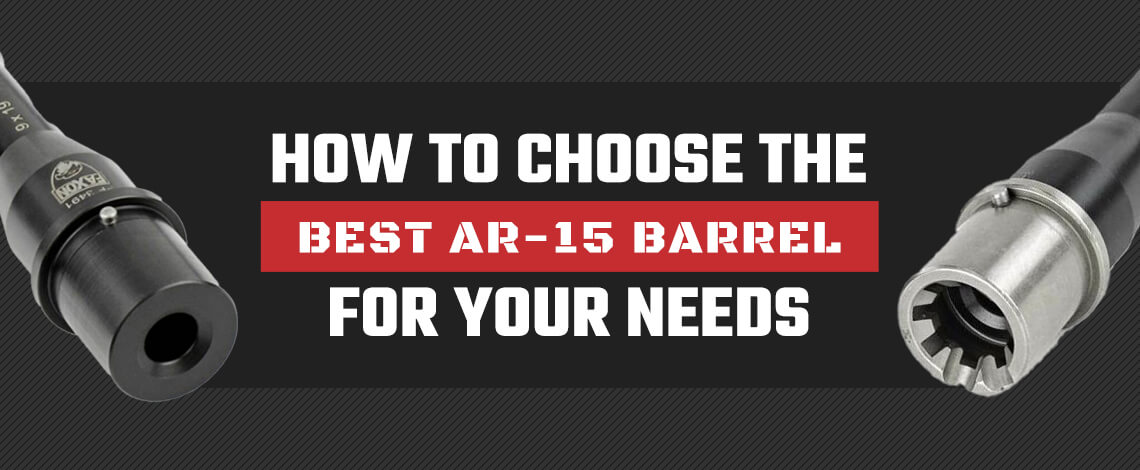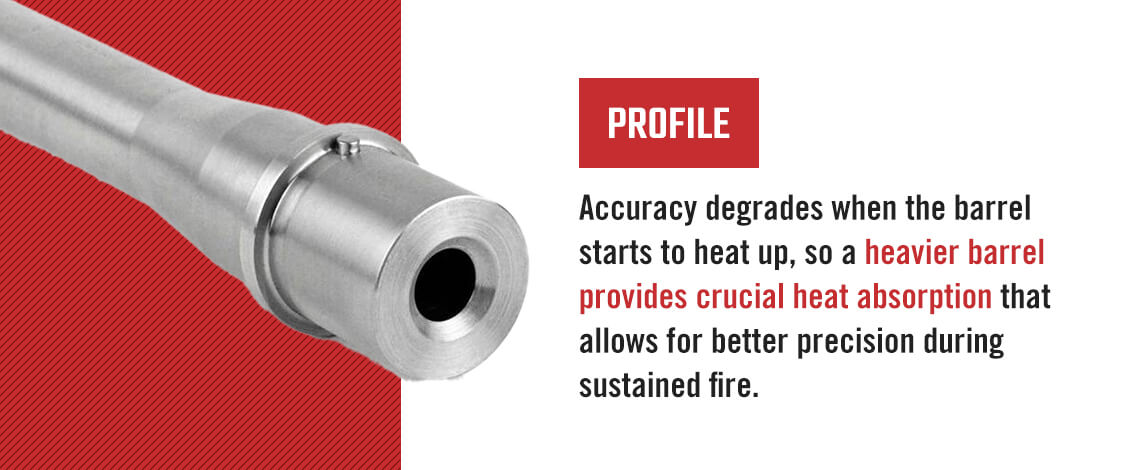
Wondering how to choose the right AR-15 barrel? That’s a question that many current and prospective owners of this popular rifle have been asking themselves since the first models hit the market back in 1959. Whether you’re purchasing a brand-new AR-15 or building your own, your choice of barrel will have a major impact on the rifle’s accuracy, performance, and longevity.
The good news is that there are plenty of options available that enable you to customize your AR-15 barrel. Careful evaluation of the following factors can be extremely beneficial when determining how to choose an AR-15 barrel that meets your unique requirements.
Length
The barrel length has a direct impact on muzzle velocity and accuracy. AR-15 barrels are available in lengths ranging from 7” to 24”, with 16” being the most common. In addition to meeting the distance requirements of most shooters, rifle barrel lengths of 16” or greater do not require a Class III tax stamp from the Bureau of Alcohol, Tobacco, Firearms and Explosives.
The way you intend to use your weapon will help you determine the most appropriate length. If you will be shooting at longer distances, a longer barrel offers increased accuracy and sufficient pressure to enable peak ammo acceleration. A shorter, lighter barrel is a better choice for maneuvering in confined areas or protecting your home. Also, keep in mind that adding one inch of length to a shorter barrel can result in a foot-per-second velocity increase of up to 200 feet. The rate of increase will begin to slow at a barrel length of 11” and pretty much disappear when reaching 20”.
Cold Hammer vs. Mil-Spec Barrels
Most AR-15 owners can get by with a standard mil-spec barrel. If you're using your AR-15 for varmint control on your property or home defense, a mil-spec barrel will suit your needs perfectly.
A mil-spec barrel is made by cutting the rifling into the barrel. Most manufacturers follow a process called “button rifling,” where they pull a cutting rod with numerous blades through a barrel blank while twisting it. After each pass, the manufacturer switches to a slightly larger button, cutting the grooves deeper each time until the rifling reaches the necessary depth.
However, heavy users will experience greater long-term benefits from a cold-hammer-forged barrel, which entails a process that uses a large hydraulic machine to hammer the barrel blanks from multiple sides. This produces a slightly tougher, more durable barrel with a longer lifespan than its mil-spec counterpart. It also provides an exceptional level of accuracy under sustained fire.
On the downside, you could pay as much as $75 or more for a cold-hammer-forged barrel. While the extra expense may not be worth it for minimal or average use, it may be worth the investment if your barrel takes a lot of abuse.
Profile

The profile refers to the weight of the barrel. Profiles are broken down into three basic categories: lightweight (also called pencil), government, and heavy. The heavier the barrel, the greater the resistance it provides to the buildup of heat when firing the weapon. Accuracy degrades when the barrel starts to heat up, so a heavier barrel provides crucial heat absorption that allows for better precision during sustained fire.
A heavier barrel will last longer than a lighter one, making it a better choice for frequent AR-15 users. On the other hand, a lighter barrel makes the gun easier to carry. Lighter barrels are also more maneuverable and easier to hold up for extended periods.
The M4 government version is the most popular profile option, as it offers an acceptable compromise for many AR-15 owners between heavier and lighter barrels.
You could also consider purchasing a barrel with fluting — also known as contour. A fluted barrel has grooves that help reduce weight and provide more surface area to release built-up heat energy faster.
Chrome vs. Stainless-Steel Lining
Mil-spec AR-15 barrels typically include a lining made of chrome poly steel for reasons that pertain mainly to longevity and cleanliness. The chrome lining is beneficial for military use in high-humidity and saltwater environments because it offers excellent resistance to corrosion. The chrome will also protect the barrel against heat and friction, helping to extend its lifespan. And because a chrome barrel is easier to clean than a stainless-steel barrel, it can further reduce the impact of corrosion and erosion over time.
Perhaps the biggest disadvantage to using chrome-lined barrels is that they can reduce the AR-15’s accuracy at long distances. This is due to the unevenness of the chrome that results in high points within the barrel. However, the loss of accuracy typically does not occur at distances under 300 yards, which means the vast majority of recreational shooters will not be impacted.
A stainless-steel barrel, also known as a “match barrel,” normally does not contain a chrome lining, providing increased accuracy at longer ranges. The downside is that stainless-steel AR-15 barrels are more susceptible to damage due to corrosion and wear, although these factors are unlikely to pose an issue when using the weapon under “normal” operating conditions and occasional to moderate use.
Twist Rate
Twist rate refers to the number of rotations a bullet makes in relation to the number of inches it travels within the barrel after the weapon is fired. For example, a 1:7 twist rate means that the bullet must travel 7” to make one complete rotation. A barrel with a 1:7 twist ratio enables a bullet to spin faster than one with a 1:9 or 1:12 ratio. A faster rotation results in greater bullet stability as it travels through the air. A 1:9 twist ratio is the most common, although the weight of the bullet is also a consideration when determining the appropriate ratio. Recommended twist ratio-ammo weight-grain combinations are:
How to Choose the Right AR-15 Barrel: Summing It All Up
When it comes to ensuring the best shooting experience, your rifle barrel is one of the most important factors. It plays a significant role in accuracy and comfort, whether you're in the field or on the range.
In essence, your choice of an AR-15 barrel pretty much comes down to your reasons for owning and using an AR-15 in the first place. If you purchase an AR-15 as a means of protecting your family and property from intruders or for occasional weekend target shooting or hunting, a standard-issue mil-spec barrel with a chrome lining is really all you need. On the other hand, if you’re a competitive shooter or someone who needs maximum accuracy at long distances, a stainless-steel, cold-hammer-forged barrel with no chrome lining is your best option.
If you want the flexibility to use your AR-15 for various purposes, a 16" barrel is the perfect middle ground, allowing you to maneuver around your home with ease and still consistently hit targets 300 yards or more away.
Weigh all the factors to determine which barrel is right for you. If you're not sure, the expert shooters at Wing Tactical can help you select a barrel that provides the durability, accuracy and overall quality you need for your intended use.
Check out the Wide Selection of AR-15 Barrels From Wing Tactical
Wing Tactical offers a large assortment of high-quality AR-15 barrels for sale from leading manufacturers such as Spike’s Tactical, ODIN Works, Seekins Precision and Northtech Defense.You also get the benefit of our hassle-free 30-day return policy, which ensures your total satisfaction. Please take a few minutes to browse our current barrel inventory and feel free to contact us for additional information regarding how to choose the best AR-15 barrel for your needs.